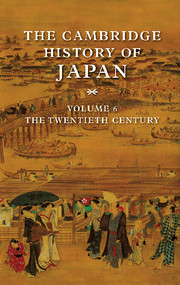Book contents
- Frontmatter
- 1 Introduction
- PART I DOMESTIC POLITICS
- PART II EXTERNAL RELATIONS
- PART III ECONOMIC DEVELOPMENT
- Part IV SOCIAL AND INTELLECTUAL CHANGE
- 11 The transformation of rural society, 1900–1950
- 12 Economic development, labor markets, and industrial relations in Japan, 1905–1955
- 13 Socialism, liberalism, and Marxism, 1901–1931
- 14 Japanese revolt against the West: political and cultural criticism in the twentieth century
- Works Cited
- Index
- References
11 - The transformation of rural society, 1900–1950
from Part IV - SOCIAL AND INTELLECTUAL CHANGE
Published online by Cambridge University Press: 28 March 2008
- Frontmatter
- 1 Introduction
- PART I DOMESTIC POLITICS
- PART II EXTERNAL RELATIONS
- PART III ECONOMIC DEVELOPMENT
- Part IV SOCIAL AND INTELLECTUAL CHANGE
- 11 The transformation of rural society, 1900–1950
- 12 Economic development, labor markets, and industrial relations in Japan, 1905–1955
- 13 Socialism, liberalism, and Marxism, 1901–1931
- 14 Japanese revolt against the West: political and cultural criticism in the twentieth century
- Works Cited
- Index
- References
Summary
It is not difficult to find continuities in the Japanese countryside. Small-scale family farming on holdings averaging less than three acres prevails today as in 1900. Despite almost a century of modern economic growth, the number of farm families has remained fairly constant, declining only slightly from five and one-half million at the turn of the century to five million in the late 1970s. There has been continuity not only in the number of farm families but also in the families themselves: The overwhelming majority of Japanese farmers today are the descendants of farmers in the Meiji era (1868–1912). As in the past they reside in small hamlets, clusters of an average of fifty to sixty farmhouses surrounded by rice paddies and upland fields. Rice remains their principal field crop, accounting for 59 percent by value of total field crop production in 1900 and 53 percent in 1970.
Yet contrasts with the past abound, and collectively they make the countryside vastly different from what it was eighty years ago. Japanese agriculture is no longer the highly labor-intensive undertaking it used to be. At the turn of the century it took roughly one hundred days of labor to grow an acre of rice. Today, owing primarily to the diffusion of capital-intensive farming methods, thirty to thirty-five days will suffice, and output per acre is almost 70 percent higher than before. The dependence of farm families on agricultural income has also declined markedly.
- Type
- Chapter
- Information
- The Cambridge History of Japan , pp. 539 - 605Publisher: Cambridge University PressPrint publication year: 1989
References
- 1
- Cited by



